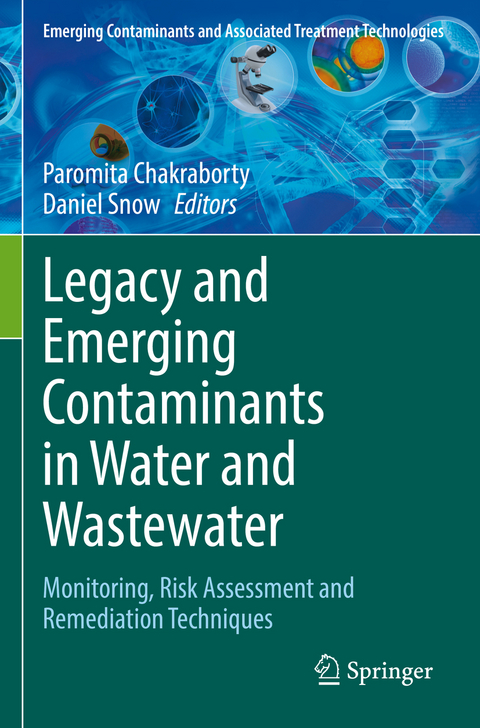
Legacy and Emerging Contaminants in Water and Wastewater
Springer International Publishing (Verlag)
978-3-030-95445-1 (ISBN)
lt;p>Daniel D. Snow is a Research Professor at the University of Nebraska, and Director of the Water Sciences Laboratory, a part of the Nebraska Water Center and Robert B. Daugherty Water for Food Institute. Over the past 30+ years, his research has focused on studying the environmental fate of emerging contaminants and agrichemicals in ground and surface water. He directs staff and students in the development of analytical methods using advanced mass spectrometry technologies to better understand and protect water resources. He has coauthored over 200 refereed journal articles, book chapters and conference proceedings. He is an associate editor for the journals Bulletin of Environmental Contamination and Toxicology and MDPI Water. He has also served as a review panelist and consultant for the American Association of Analytical Chemists, Environmental Protection Agency, National Science Foundation, Department of Defense, Gulf of Mexico Research Initiative, CRDF Global and several international research funding programs.
Dr. Paromita Chakraborty is Associate Professor at the Department of Chemical Engineering in SRM Institute of Science and Technology, Kattankulathur, Tamil Nadu. Dr.Chakraborty leads the Environmental Science and Technology research group and working on the multimedia transport of legacy and new persistent organic pollutants, bioavailability of organic contaminants, environmental chemistry, transformation and remediation of endocrine disrupting compounds, mismanagement of plastic and electronic waste, conversion of waste into wealth. Dr.Chakraborty is the principal investigator for projects funded by national funding agencies like DST, MoEFCC and international funding agencies like Research Council of Norway, Norwegian Embassy and Swiss Development Cooperation. She has published over 100 peer reviewed journal articles and book chapters. . Her research has been used as the basis for the creation of several policy briefs that were important for decision makers. She is the recipient of prestigious Water Advanced Research and Innovation (WARI) Fellowship 2016, awarded by the Indo-US Science and Technology Forum. Among numerous awards that Dr Chakraborty received, Early career chemist 2015 and Hiyoshi Environmental Award 2020 are the most prestigious ones. Dr. Chakraborty is the special mentor for the Association of Common Wealth Universities Blue Charter Fellowship. She is an associate editor in the Arabian Journal of Geosciences and is in the editorial board of the Science of the Total Environment journal.Part 1: State of the science on organic micropollutants in water and wastewater.- Chapter 1-Emerging contaminants in water and wastewater: monitoring, risk assessment and remediation techniques.- Chapter 2-Legacy and emerging contaminants in water: Origin, distribution and implications for human exposure and health.- Chapter 3-Groundwater contamination by persistent organic pollutants in India- A review.- Chapter 4-Fate, Transport and Effects of Pharmaceuticals and Personal Care Products in Urban Environment.- Chapter 5-Phenoxyacid herbicides in water ecosystems- a review on their fate, risk assessment and remediation techniques.- Part 2: Monitoring of organic micropolluntants and their associated risks.- Chapter 6-Water contamination and sources of plasticizers in Asia: a review.- Chapter 7-Antifouling Strategies & Environmental Issues in Industrial Cooling Water Systems in the Marine Environment.- Chapter 8-Measuring emerging contaminants in freshwater systems.- Chapter 9-Optical Techniques in Monitoring of Persistent Organic Pollutants (POPs) in Water and Waste Water.- Part 3: Current approaches for remediation of organic micropollutants.- Chapter 10-Pharmaceuticals in Indian Aquatic Environment: Risk and Implications for Management.- Chapter 11-Suspect and Non-target Screening of Pharmaceuticals in Water and Wastewater Matrices.- Chapter 12-Human exposure and health risks.- Chapter 13-Carbamazepine Residues in Wastewater and River Water: Occurrence, Estimation of Use, and Disposal of this Drug in a Small Community in Western Kentucky, USA.- Chapter 14-Source, Treatment and Management Options of Contaminants of Emerging Concerns (CECs) in Water.- Chapter 15-Emerging Contaminants in Water: Potential Risks and Remedial Techniques.- Chapter 16-Emerging Contaminants Removal from Domestic Wastewater by Advanced Treatment Technologies.- Chapter 17-Treatment Technologies for Emerging Contaminants in Water and Wastewater.- Chapter 18-Novel strategies to treat organic micropollutants.- Chapter 19-Advanced treatment technologies to combat antibiotic resistant bacteria and antibiotic resistance genes from urban wastewater.- Chapter 20-Nanotechnology based treatment strategies for removal of antibiotic and antibiotic byproducts from waste water.- Chapter 21-Levels, sources and removal efficiency of PCDDs/PCDFs and dl-PCBs in water and wastewater in Poland and Europe under the European water directives.
| Erscheinungsdatum | 06.06.2023 |
|---|---|
| Reihe/Serie | Emerging Contaminants and Associated Treatment Technologies |
| Zusatzinfo | XII, 415 p. 137 illus., 99 illus. in color. |
| Verlagsort | Cham |
| Sprache | englisch |
| Maße | 155 x 235 mm |
| Gewicht | 652 g |
| Themenwelt | Sachbuch/Ratgeber ► Natur / Technik ► Natur / Ökologie |
| Naturwissenschaften ► Biologie ► Ökologie / Naturschutz | |
| Naturwissenschaften ► Geowissenschaften | |
| Schlagworte | Emerging Contaminants • Health Risk • Legacy contaminants • micropollutants • Persistent Organic Pollutants • wastewater |
| ISBN-10 | 3-030-95445-5 / 3030954455 |
| ISBN-13 | 978-3-030-95445-1 / 9783030954451 |
| Zustand | Neuware |
| Haben Sie eine Frage zum Produkt? |
aus dem Bereich


